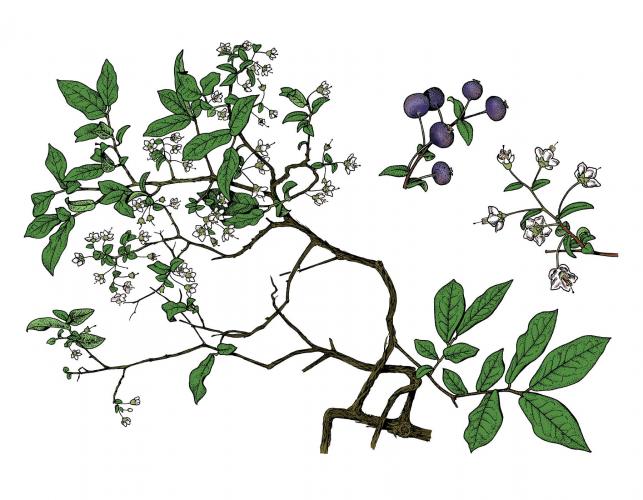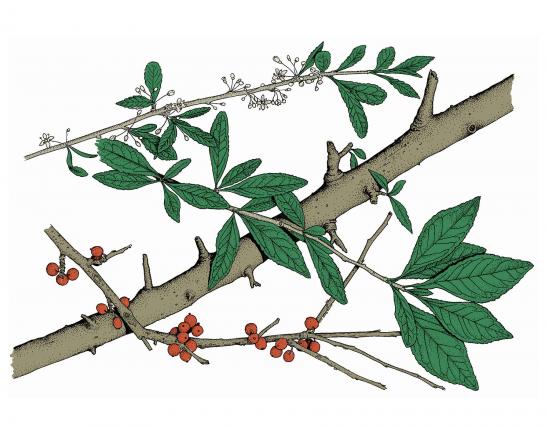
Deerberry is an irregularly branched shrub, rarely more than 6 feet high. A blueberry relative, it bears edible blue fruits.
Leaves are alternate, simple, ¾–2¾ inches long, ½–1 inch wide, slightly broader above the middle; the tip pointed; the base narrow, rounded; the margin entire, fringed with hairs; the upper surface dull, light green to yellow green, mostly smooth; the lower surface duller and hairy,with conspicuous veins, hairy; the leaf stalk is very short. Note that small leaves (bracts) are present at the base of the flower and fruit stalks.
Bark is gray to brown, rather smooth, split into long, narrow, papery strips with loose margins; the inner bark is reddish brown; the wood is soft, fine grained, white to pale brown.
Twigs are slender; the growth of the current year is green to reddish, hairy; later, it becomes green to brown and smooth.
Flowers April–June, in loose, hanging clusters with 3–10 flowers; flowers white, sometimes purplish-tinged, broadly bell-shaped, wider than long, about ¼ inch across, 5-lobed, lobed to about the midpoint, lobes spreading; stamens 10, extending beyond the flower.
Fruits July–September, about ¼ inch in diameter, globe-shaped, blue, often with a whitish waxy coating, not shiny, somewhat sweet; seeds egg-shaped, golden brown, finely pitted.
Similar species: Four species of Vaccinium (blueberries) have been recorded as native or naturalized in Missouri. In addition to deerberry, our other native blueberries are farkleberry (V. arboreum) and lowbush blueberry (V. pallidum). The fourth, highbush or swamp blueberry (V. corymbosum), is apparently introduced; it’s uncommon in our state, known from a historical collection of a possibly native occurrence in Newton County, and a more recent, introduced occurrence in Ste. Genevieve County, where fruit plantings apparently escaped from cultivation. It’s an important fruit crop in the eastern and midwestern United States.
Another species, black huckleberry (Gaylussacia baccata), is in the same family as blueberries. Its leaves have numerous tiny, sticky, yellow resin dots (glands), at least on the undersurface, and its fruits (technically drupes, not berries) are leathery with 10 seedlike nutlets (whereas blueberries are berries with numerous seeds). It is critically imperiled in Missouri and known (for certain) only from a few sites in Montgomery and Perry counties.
Height: to 6 feet.
Scattered almost entirely in the Ozarks, and in the eastern portion of the Ozark border.
Habitat and Conservation
Occurs in acidic soils over sandstone, chert, and igneous bedrock; habitats include rocky, open, dry or moist woods, ridges, upland slopes, and glades.
This species is often associated with recently burned sites, and it may require fire conditions to promote seed germination.
Deerberry frequently grows in association with lowbush blueberry; where they occur together, deerberry is typically the larger shrub with larger leaves and larger fruits.
Status
Native shrub bearing edible fruits.
Human Connections
The fruit is used in pies and jellies or eaten fresh. Berry flavor may vary by individual plant. Make jam or jelly as you would other berries. The basic idea for jelly is to boil the berries in enough water to cover; pour off the juicy liquid and add to it sugar (to taste) and pectin gelling agent; boil the liquid again until gelling starts; skim the foam from the top; and pour into jars.
Vaccinium is the classical Latin name for an Old World species; stamineum refers to the prominent stamen structure.
Vaccinium is the blueberry genus, so deerberry is closely related to the blueberries we know from jams, pies, muffins, and juices. In North America, several species of blueberries have been improved by plant breeders and are cultivated commercially, mostly in the northern and northeastern United States and Canada. These include the highbush blueberry (V. corymbosum), sweet lowbush blueberry (V. angustifolium), and cranberry (V. macrocarpon). Many other species of blueberry are harvested from the wild, including the lowbush or hillside blueberry (V. pallidum) in Missouri. Deerberry and farkleberry are generally considered less tasty, but individual plants may yield good fruit.
Expanding outward from genus, the blueberries belong to the heath or heather family (Ericaceae), a large and diverse family that includes many cultivated plants, including rhododendrons and azaleas, trailing arbutus, bearberry, mountain laurel, pieris/andromeda/fetterbush, and more. Most of these require acidic soils to do well, making them difficult to grow in many locations in our state, given the widespread calcareous soils in Missouri.
If you’ve been to the American west, you may have seen shrubby or ground-hugging manzanitas (Arctostaphylos spp.) or mountain heaths or heathers (Phyllodoce spp.). They’re in the same family. The downturned urn- or bell-shaped flowers are very distinctive in this family. Learning plant families usually involves recognizing similar flower and fruit forms.
Ecosystem Connections
At least 14 species of birds eat the fruit, including eastern bluebird, scarlet tanager, northern bobwhite, wild turkey, and ruffed grouse. Other fruit-specialist birds include cedar waxwing, American robin, gray catbird, northern mockingbird, brown thrasher, orioles, blue jay, northern cardinal, chickadees, titmice, finches, and grosbeaks.
White-tailed deer favor the leaves and stems. Mammals that may eat the fruit include foxes, white-tailed deer, American black bear, chipmunks, mice, opossum, and raccoon.
The flowers of Vaccinium species are visited by large numbers of bees, mostly various types of bumblebees and andrenid bees, but also honeybees. Pollinators receive both nectar (from a disk inside the base of the bell-shaped fused petals) and pollen as their reward. Pollen accumulated in the long, narrow tubes falls out of the downward-facing flowers or is “buzzed” or vibrated out when they are disturbed by an insect visitor.
The flowers of Vaccinium species have characteristics that prevent them from self-fertilizing. For example, the flowers are usually protandrous; that is, the stamens (pollen-bearing structures) mature first, with the styles (pollen-receiving structures) maturing later (pro- means “before”; androus means “male”). The stigmas become receptive to pollen only after the pollen of their own blossom has been dispersed.
A wide range of insects feed on various parts of Vaccinium species — beetles, flies, true bugs including aphids and other sucking insects, and grasshoppers. In many cases, the insect is specialized for eating only members of the Vaccinium genus or their close relatives, and nothing else.
Several species of butterflies and moths use Vaccinium species as their larval host plants. Examples are Henry’s elfin, spring azure, Harris’s three-spot, decorated owlet, azalea sphinx, pawpaw sphinx, huckleberry sphinx, apple sphinx, and yellow-washed metarranthis. As with other insects, some of these must use only blueberries and their close relatives as their food plants, while others are polyphagous (able to eat a wider variety of plants).





























